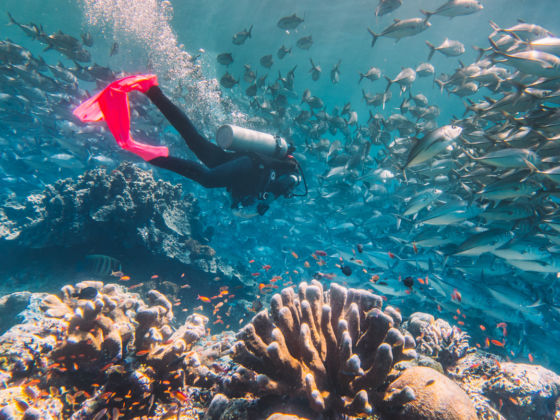People often start off in conservation with great intentions. They become activists. They advocate for causes. But they can quickly get bogged down and discouraged when reality hits: conservation isn’t black and white. Successful conservationists learn to view the “other side” (typically resource extraction industries) not as the enemy per se but as potential partners in solving problems long term. And to do this, everyone involved must learn to look at things from a new perspective.


Matador Originals Presents, Rigs to Reef: Transecting Borneo
Nowhere is this hypothetical more apt than with offshore oil rigs. Most people see offshore oil platforms as huge industrial blots on the ocean. And yet marine conservation scientists Amber Jackson and Emily Callahan are helping uncover a remarkable story: the thriving ecosystems formed on these structures beneath the surface.
The two co-founded Blue Latitudes, a company that landed them coveted spots on Forbes 30 Under 30 list. Their mission is to transform old offshore oil platforms into artificial reefs, avoiding the huge carbon footprint that occurs when the structures are removed, and encouraging the development of thriving marine ecosystems. These artificial reefs not only preserve new habitat but can also create public awareness around ocean conservation.
To accomplish this, Blue Latitudes conducts scientific research, including ecological value assessments through diving as well as Remotely Operated Vehicle (ROV) surveys (essentially underwater drones). They also advocate for environmental support through media campaigns and work with regulators and industry stakeholders.
Matador Originals’ new documentary Rigs to Reef: Transecting Borneo follows Amber and Emily on an epic journey across Malaysia and back to California where they attempt to gather data via “transects,” essentially monitoring all marine life that’s found in a given area. The goal is to demonstrate the ecological value of artificial reefs.
They first visit Seaventures, the world’s only decommissioned oil rig transformed into a dive resort. From there, they dive off the nearby island of Mabul, which allows them to compare data of the artificial reef with that of a human-impacted natural reef.
From here they explore Sipadan Island, one of the world’s most pristine marine ecosystems. Finally, they return to California to compare data, which leads to some surprising results.
As with all conversation stories, Rigs to Reef starts with people’s deep connections to place and from there, their desire to protect it. Amber Jackson grew up in Southern California. As a kid, she spent her days swimming through kelp forests and jumping in blowholes. On the opposite coast, Emily Callahan grew up on tiny New Castle Island off of New Hampshire. Her afternoons were filled with trips to the beach to go tide-pooling where she’d bring marine collections back to the house in sea-water filled buckets.
Ultimately, both women were able to channel their love for the sea into academic pursuits, both getting M.A.S. degrees in Marine Biodiversity and Conservation from Scripps Institution of Oceanography. Collectively, they’ve contributed to ocean floor mapping for Google Earth, helped in cleanup efforts on the BP 252 Oil Spill in the Gulf of Mexico, and represent PADI Dive Ambassadors.